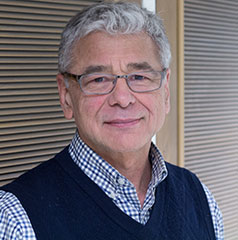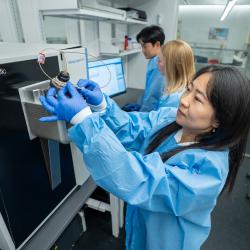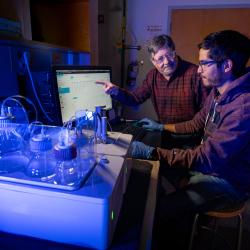Pioneering Air Quality Researcher Retired in June
Professor and Alumnus John Ondov’s departure marks the end of an era at UMD.
Over the course of his career, Department of Chemistry and Biochemistry Professor John Ondov (Ph.D. ’74, chemistry) practically wrote the book on environmental air quality measurement and monitoring for the Environmental Protection Agency (EPA). A professor at UMD for 35 years, Ondov was part of a core group of environmental researchers in the department.

Ondov is particularly well known for developing methods to characterize atmospheric aerosols (fine particles) and track air pollution to its source. Early in his career, he demonstrated how to measure the size distribution of aerosols emitted from combustion sources. He then set his research sights on particle composition measurements, which offered the potential to reveal the source of the pollution.
Ondov applied nuclear-analytical methods pioneered by UMD chemists in the 1970s to detect trace quantities of elements—such as selenium, uranium and lead—in aerosol particles. These trace elements, could number as few as 10 picograms in a single carbon soot particle and were invisible to the EPA monitors of air quality at the time. Ondov showed the EPA how to quantify heavy metals and other elements in airborne particles. Next, he developed an instrument compact enough to fit in a small van that could rapidly sample air for particles. Dubbed the Semicontinuous Elements in Aerosol Sampler (SEAS), this innovative instrument provided essential air-quality data for the EPA Supersite Program, which aimed to characterize airborne particulates from various sources and develop advanced measurement methods to improve scientific understand the impacts of aerosols on human health.
SEAS was used at the supersite in Baltimore where Ondov was the chief architect and lead principal investigator. SEAS was also used at supersites in Pittsburgh and St. Louis as well as sites in Canada and Florida.
The results were astounding: the impact of different pollution sources on air quality could be observed 25 miles from the source based on the composition of particles in the air. With these data, Ondov’s group was able to construct the Pseudo-Deterministic Receptor Model (PDRM) and quantify the rate of aerosol particle emission from the sources and their effect on air quality. SEAS became the cornerstone of the EPA’s source apportionment research for nearly a decade.
“John was a brilliant investigator,” said his colleague, Chemistry and Biochemistry Professor William “Bill” Walters. “He raised tons of money and built this incredible network of sampling sites that had all kinds of implications for understanding the effect of particulate matter on human health.”
More recently, Ondov’s research shifted from what’s in the air to what’s on the dinner plate. Phthalic acid esters (“phthalates”) found in foods were known to be endocrine disruptors (chemicals that can interfere with the body’s hormonal system). But it was unclear whether food phthalates were the result of industrial contamination or the product of natural biological processes. Working with the U.S. Food and Drug Administration (FDA), Ondov extracted phthalates from fatty foods and purified them for radiocarbon analysis by accelerator mass spectrometry. His group found that at least 60% of phthalates in food were derived from industrial contamination.
As a teacher, Ondov passed on to his students his enthusiasm for approaching tough questions with an inquisitive attitude. “He taught me that chemistry is more than plug-and-chug,” said Allison Keyes, an undergraduate who took one of Ondov’s courses. “He encouraged us to think about course material in new ways, and as a result, I truly learned.”
As Ondov prepared for retirement, we asked him to look back on his career and to the future of analytical chemistry.
When you first came to UMD in 1970 as a graduate student, there was a lot of public interest in environmental issues. Is that what influenced your decision to study air quality?
Well, that was the year of the first Earth Day, so there was a lot of excitement about environmental matters. That had an impact on me, but there were other factors as well. In my last year of college, I had interviews with Colgate-Palmolive and Johnson & Johnson. There, the chemists worked in the lab for the first year or two and then went out into the sales force to learn what customers wanted. Then, the chemists would go back to the lab and make new improvements and products.
I asked for an example of the kind of products these chemists were developing, and I was told about this new clear toothpaste. When I asked if it was any better than the white toothpaste, I was told, “No, but it’s selling like hotcakes.” I thought, “If it’s not better, then what’s the point.” I just wasn’t interested in that.
On the other hand, when looking at graduate schools, I saw that the University of Maryland had a new air chemistry program that included Professors Glen Gordon, Bill Zoller, Bill Walters and George Helz. The Analytical, Nuclear, Environmental (ANE) Chemistry group at Maryland was particularly known for nuclear analysis methods. They had new state-of-the-art gamma-ray detectors and used the superb nuclear reactor and linear accelerator facilities at NBS (now NIST) in Gaithersburg. That seemed exciting. There were so many facets of the research. I would get to do analytical work, particle science, engineering and micrometeorology, and I would get to make measurements outdoors rather than always being cooped up in a laboratory.
After receiving your Ph.D. in chemistry here at UMD, you went to Lawrence Livermore National Laboratory (LLNL) where your work caught the attention of the EPA and set you on a path for much of your career. Tell us about that.
Coal-fired power plants have long been known to be major sources of gaseous and particulate pollutants. In the late 1970s, the EPA lacked really good measurements of the emission rates and the size distributions of particles emitted from utility power plants. The EPA was even more limited in its ability to measure elemental and chemical constituents. One very important thing we did at LLNL was to painstakingly determine the sizes of particles emitted using scanning electron microscopy. That, coupled with analyses by instrumental neutron activation, allowed us to move ahead to better understand how toxic elements became enriched on the particles and how they evolve after being discharged to the atmosphere.
For example, we definitively demonstrated that particles emitted from coal burners had two principle size ranges: large ash particles that are collected more efficiently by the power plant’s control equipment and tiny particles formed by condensation from the gas phase. With this data, we used the lab’s first supercomputer (CRAY I) to compute how the sizes of the particles we measured changed after discharge into the atmosphere. The detailed modeling of growth and removal mechanisms made possible by the CRAY allowed us to make quantitative predictions. The results indicated that the sizes of the tiny particles would remain intact for very large distances downwind and should therefore be detected at ground-based air quality measurement sites. Before I left LLNL, my group teamed up with UMD Chemistry and Biochemistry Professor William H. Zoller and his graduate student Carl E Choquette to measure the changes predicted for particles emitted from the smoke stack of a large western coal-fired power plant. The model results were correct. This paved the way for my work at ground-based sites after I returned to Maryland.
When I joined the Maryland faculty in 1984, I started measuring the air particles at EPA sampling sites downwind from power plants. I demonstrated that we could identify the source of air plumes from things like power plants, incinerators and steel mills through our measurements and models.
What would you like your legacy to be?
I don’t know about “legacy.” I’d like people to remember me as a man who had very high standards and great enthusiasm for his work and was able to pass some of that along to his students. I cherish that my colleagues praised me for how well my students were trained. I enjoyed the reputation—both here and in Europe—of doing the best new work of anyone in the fields of source apportionment and particle dry deposition. The Electric Power Research Institute, the EPA, the Department of Energy, LLNL and Martin Marietta loved my enthusiasm and my ideas and funded my research handsomely.
I’d like to think, also, that I really made a meaningful contribution to the state of Maryland in 2006, the final year of the 20 years I served on the Air Quality Control Advisory Council for the Maryland Secretary of the Environment. The EPA had mandated that all of the states install scrubbers on utility power plants to reduce sulfur dioxide by 70%, but Maryland’s governor at that time, Martin O’Malley, wanted to be more aggressive and go up to 80%. In addition, he wanted the scrubbers to be installed on each and every coal-fired power plant in the State of Maryland. I was instrumental in convincing Governor O’Malley that Maryland was best served by embracing the EPA’s rule for 70% reduction of sulfur dioxide emissions and a strategy of closing power plants with short smokestacks in highly populated areas and increasing the generating capacity of the Calvert Cliffs Nuclear Power Plant. I estimate that Maryland saved between $500 million and $2 billion, possibly enough to pay for the second planned unit at Calvert Cliffs. Unfortunately, when Fukushima came along, the plan for the Calvert Cliffs expansion was dropped.
When you look forward to the future, where do you see the biggest advances in analytical chemistry?
I think the idea of doing rapid chemical analyses on small timescales with small amounts of sample has great potential for the medical field. We have already seen this with continuous blood glucose monitors. But, I suspect that in 20 or 30 years, we’ll have the ability to determine the kinetics of the extremely complicated biological systems that make up our bodies. I think that will eventually allow the majority of the population to find the right doses of medicines and optimal blood levels needed to achieve optimum health.
Professor and Alumnus John Ondov’s departure marks the end of an era at UMD
Over the course of his career, Department of Chemistry and Biochemistry Professor John Ondov (Ph.D. ’74, chemistry) practically wrote the book on environmental air quality measurement and monitoring for the Environmental Protection Agency (EPA). A professor at UMD for 35 years, Ondov was part of a core group of environmental researchers in the department.
Ondov is particularly well known for developing methods to characterize atmospheric aerosols (fine particles) and track air pollution to its source. Early in his career, he demonstrated how to measure the size distribution of aerosols emitted from combustion sources. He then set his research sights on particle composition measurements, which offered the potential to reveal the source of the pollution.
Ondov applied nuclear-analytical methods pioneered by UMD chemists in the 1970s to detect trace quantities of elements—such as selenium, uranium and lead—in aerosol particles. These trace elements, could number as few as 10 picograms in a single carbon soot particle and were invisible to the EPA monitors of air quality at the time. Ondov showed the EPA how to quantify heavy metals and other elements in airborne particles. Next, he developed an instrument compact enough to fit in a small van that could rapidly sample air for particles. Dubbed the Semicontinuous Elements in Aerosol Sampler (SEAS), this innovative instrument provided essential air-quality data for the EPA Supersite Program, which aimed to characterize airborne particulates from various sources and develop advanced measurement methods to improve scientific understand the impacts of aerosols on human health.
SEAS was used at the supersite in Baltimore where Ondov was the chief architect and lead principal investigator. SEAS was also used at supersites in Pittsburgh and St. Louis as well as sites in Canada and Florida.
The results were astounding: the impact of different pollution sources on air quality could be observed 25 miles from the source based on the composition of particles in the air. With these data, Ondov’s group was able to construct the Pseudo-Deterministic Receptor Model (PDRM) and quantify the rate of aerosol particle emission from the sources and their effect on air quality. SEAS became the cornerstone of the EPA’s source apportionment research for nearly a decade.
“John was a brilliant investigator,” said his colleague, Chemistry and Biochemistry Professor William “Bill” Walters. “He raised tons of money and built this incredible network of sampling sites that had all kinds of implications for understanding the effect of particulate matter on human health.”
More recently, Ondov’s research shifted from what’s in the air to what’s on the dinner plate. Phthalic acid esters (“phthalates”) found in foods were known to be endocrine disruptors (chemicals that can interfere with the body’s hormonal system). But it was unclear whether food phthalates were the result of industrial contamination or the product of natural biological processes. Working with the U.S. Food and Drug Administration (FDA), Ondov extracted phthalates from fatty foods and purified them for radiocarbon analysis by accelerator mass spectrometry. His group found that at least 60% of phthalates in food were derived from industrial contamination.
As a teacher, Ondov passed on to his students his enthusiasm for approaching tough questions with an inquisitive attitude. “He taught me that chemistry is more than plug-and-chug,” said Allison Keyes, an undergraduate who took one of Ondov’s courses. “He encouraged us to think about course material in new ways, and as a result, I truly learned.”
As Ondov prepared for retirement, we asked him to look back on his career and to the future of analytical chemistry.
When you first came to UMD in 1970 as a graduate student, there was a lot of public interest in environmental issues. Is that what influenced your decision to study air quality?
Well, that was the year of the first Earth Day, so there was a lot of excitement about environmental matters. That had an impact on me, but there were other factors as well. In my last year of college, I had interviews with Colgate-Palmolive and Johnson & Johnson. There, the chemists worked in the lab for the first year or two and then went out into the sales force to learn what customers wanted. Then, the chemists would go back to the lab and make new improvements and products.
I asked for an example of the kind of products these chemists were developing, and I was told about this new clear toothpaste. When I asked if it was any better than the white toothpaste, I was told, “No, but it’s selling like hotcakes.” I thought, “If it’s not better, then what’s the point.” I just wasn’t interested in that.
On the other hand, when looking at graduate schools, I saw that the University of Maryland had a new air chemistry program that included Professors Glen Gordon, Bill Zoller, Bill Walters and George Helz. The Analytical, Nuclear, Environmental (ANE) Chemistry group at Maryland was particularly known for nuclear analysis methods. They had new state-of-the-art gamma-ray detectors and used the superb nuclear reactor and linear accelerator facilities at NBS (now NIST) in Gaithersburg. That seemed exciting. There were so many facets of the research. I would get to do analytical work, particle science, engineering and micrometeorology, and I would get to make measurements outdoors rather than always being cooped up in a laboratory.
After receiving your Ph.D. in chemistry here at UMD, you went to Lawrence Livermore National Laboratory (LLNL) where your work caught the attention of the EPA and set you on a path for much of your career. Tell us about that.
Coal-fired power plants have long been known to be major sources of gaseous and particulate pollutants. In the late 1970s, the EPA lacked really good measurements of the emission rates and the size distributions of particles emitted from utility power plants. The EPA was even more limited in its ability to measure elemental and chemical constituents. One very important thing we did at LLNL was to painstakingly determine the sizes of particles emitted using scanning electron microscopy. That, coupled with analyses by instrumental neutron activation, allowed us to move ahead to better understand how toxic elements became enriched on the particles and how they evolve after being discharged to the atmosphere.
For example, we definitively demonstrated that particles emitted from coal burners had two principle size ranges: large ash particles that are collected more efficiently by the power plant’s control equipment and tiny particles formed by condensation from the gas phase. With this data, we used the lab’s first supercomputer (CRAY I) to compute how the sizes of the particles we measured changed after discharge into the atmosphere. The detailed modeling of growth and removal mechanisms made possible by the CRAY allowed us to make quantitative predictions. The results indicated that the sizes of the tiny particles would remain intact for very large distances downwind and should therefore be detected at ground-based air quality measurement sites. Before I left LLNL, my group teamed up with UMD Chemistry and Biochemistry Professor William H. Zoller and his graduate student Carl E Choquette to measure the changes predicted for particles emitted from the smoke stack of a large western coal-fired power plant. The model results were correct. This paved the way for my work at ground-based sites after I returned to Maryland.
When I joined the Maryland faculty in 1984, I started measuring the air particles at EPA sampling sites downwind from power plants. I demonstrated that we could identify the source of air plumes from things like power plants, incinerators and steel mills through our measurements and models.
What would you like your legacy to be?
I don’t know about “legacy.” I’d like people to remember me as a man who had very high standards and great enthusiasm for his work and was able to pass some of that along to his students. I cherish that my colleagues praised me for how well my students were trained. I enjoyed the reputation—both here and in Europe—of doing the best new work of anyone in the fields of source apportionment and particle dry deposition. The Electric Power Research Institute, the EPA, the Department of Energy, LLNL and Martin Marietta loved my enthusiasm and my ideas and funded my research handsomely.
I’d like to think, also, that I really made a meaningful contribution to the state of Maryland in 2006, the final year of the 20 years I served on the Air Quality Control Advisory Council for the Maryland Secretary of the Environment. The EPA had mandated that all of the states install scrubbers on utility power plants to reduce sulfur dioxide by 70%, but Maryland’s governor at that time, Martin O’Malley, wanted to be more aggressive and go up to 80%. In addition, he wanted the scrubbers to be installed on each and every coal-fired power plant in the State of Maryland. I was instrumental in convincing Governor O’Malley that Maryland was best served by embracing the EPA’s rule for 70% reduction of sulfur dioxide emissions and a strategy of closing power plants with short smokestacks in highly populated areas and increasing the generating capacity of the Calvert Cliffs Nuclear Power Plant. I estimate that Maryland saved between $500 million and $2 billion, possibly enough to pay for the second planned unit at Calvert Cliffs. Unfortunately, when Fukushima came along, the plan for the Calvert Cliffs expansion was dropped.
When you look forward to the future, where do you see the biggest advances in analytical chemistry?
I think the idea of doing rapid chemical analyses on small timescales with small amounts of sample has great potential for the medical field. We have already seen this with continuous blood glucose monitors. But, I suspect that in 20 or 30 years, we’ll have the ability to determine the kinetics of the extremely complicated biological systems that make up our bodies. I think that will eventually allow the majority of the population to find the right doses of medicines and optimal blood levels needed to achieve optimum health.






